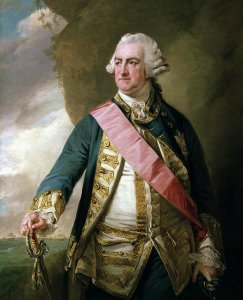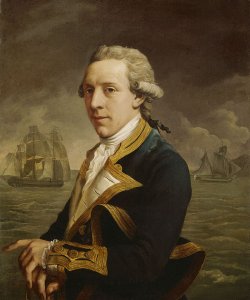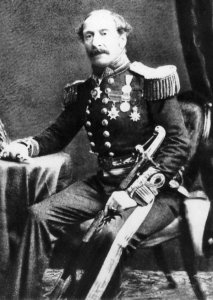Today in Naval History - Naval / Maritime Events in History
15th of February
some of the events you will find here,
please use the following link where you will find more details and all other events of this day .....
1760 - HMS Ramillies (90) driven ashore and wrecked in what is today Ramillies Cove near Salcombe, Devon
HMS Royal Katherine (HMS Ramilles after 1706) was an 84-gun second-rate ship of the line of the Royal Navy, launched in 1664 at Woolwich Dockyard. Her launching was conducted by Charles II and attended by Samuel Pepys. Royal Katherine fought in the Second and Third Anglo-Dutch Wars and the War of the Grand Alliance before entering the dockyard at Portsmouth for rebuilding in 1702. She was upgraded to carry 90 guns and served in the War of the Spanish Succession during which she was renamed Ramillies in honour of John Churchill's victory at the Battle of Ramillies. She was rebuilt again in 1742–3 before serving as the flagship of the ill-fated Admiral John Byng in the Seven Years' War. Ramillies was wrecked at Bolt Tail near Hope Cove on 15 February 1760.

1775 - HMS Halifax schooner (10) wrecked.
HMS Halifax was a schooner built for merchant service at Halifax, Nova Scotia in 1765 that the British Royal Navy purchased in 1768 for coastal patrol in North America in the years just prior to the American Revolution. She is one of the best documented schooners from early North America.


1782 - The Action of 15 January 1782
The Action of 15 January 1782 was a minor naval engagement that took place near the island of Jamaica during the American Revolutionary War. A Royal Naval frigate HMS Fox intercepted and engaged two small Spanish Navy frigates.
1783 - Action of 15 February 1783
The Action of 15 February 1783 was a small naval engagement of the American Revolutionary War, involving the 36-gun French Navy frigate Concorde and the Royal Navy 74-gun ship of the line Magnificent. The British were victorious when Concorde was overhauled and captured.
1794 – Launch of HMS Lark, a 16-gun ship sloop of the Cormorant class,
HMS Lark was a 16-gun ship sloop of the Cormorant class, launched in 1794 at Northfleet. She served primarily in the Caribbean, where she took a number of prizes, some after quite intensive action. Lark foundered off San Domingo in August 1809, with the loss of her captain and almost all her crew.

1804 - Battle of Pulo Aura
The Battle of Pulo Aura was a minor naval engagement of the Napoleonic Wars, fought on 14 February 1804, in which a large convoy of Honourable East India Company (HEIC) East Indiamen, well-armed merchant ships, intimidated, drove off and chased a powerful French naval squadron. Although the French force was much stronger than the British convoy, Commodore Nathaniel Dance's aggressive tactics persuaded Contre-Admiral Charles-Alexandre Durand Linois to retire after only a brief exchange of shot. Dance then chased the French warships until his convoy was out of danger, whereupon he resumed his passage toward British India. Linois later claimed that the unescorted British merchant fleet was defended by eight ships of the line, a claim criticised by contemporary officers and later historians.

1809 - HMS Belle Poule (38), Cptn. James Brisbane, captured French frigate Var (26) in the Gulf of Valona, Adriatic
Var was a corvette of the French Navy, launched in 1806 as the name-ship of her class of flutes. She served as a storeship until the British captured her in 1809. She became the transport HMS Chichester, and was wrecked in 1811.
HMS Belle Poule was a Royal Navy fifth rate frigate, formerly Belle Poule, a Virginie-class frigate of the French Navy, which was built by the Crucy family's shipyard at Basse-Indre to a design by Jacques-Noël Sané. She was launched on 17 April 1802, and saw active service in the East, but in 1806 a British squadron under Sir John Borlase Warren captured her off La Palma in the Canary Islands. The Admiralty commissioned her into the Royal Navy as HMS Belle Poule. She was sold in 1816.

1854 – Launch of French Le Donawerth, a 90-gun Suffren class ship of the line of the French Navy.


1898 – The battleship USS Maine explodes and sinks in Havana harbor in Cuba.
Of the 374 officers and men aboard, 266 died immediately, another eight died later from their injuries. The ship's sinking precipitated the Spanish–American War.
USS Maine (ACR-1) was a US Navy ship that sank in Havana Harbor during the Cuban revolt against Spain, an event that became a major political issue in the United States.

1944 - japanese cruiser Agano (阿賀野), the lead ship of the Agano-class cruisers, sunk by USS Skate
Agano (阿賀野) was the lead ship of the Agano-class cruisers which served with the Imperial Japanese Navy (IJN) during World War II. She was named after the Agano River in Fukushima and Niigata prefectures in Japan.

Japanese light cruiser Agano off Sasebo in October 1942
1982 – The drilling rig Ocean Ranger sinks during a storm off the coast of Newfoundland, killing 84 workers.
Ocean Ranger was a semi-submersible mobile offshore drilling unit that sank in Canadian waters on 15 February 1982. It was drilling an exploration well on the Grand Banks of Newfoundland, 267 kilometres (166 mi) east of St. John's, Newfoundland, for Mobil Oil of Canada, Ltd. (MOCAN) with 84 crew members on board when it sank. There were no survivors.

15th of February
some of the events you will find here,
please use the following link where you will find more details and all other events of this day .....
Naval/Maritime History - 27th of August - Today in Naval History - Naval / Maritime Events in History
Today in Naval History - Naval / Maritime Events in History 15 February 1760 - HMS Ramillies (90) driven ashore and wrecked in what is today Ramillies Cove near Salcombe, Devon HMS Royal Katherine (HMS Ramilles after 1706) was an 84-gun second-rate ship of the line of the Royal Navy, launched...
shipsofscale.com
1760 - HMS Ramillies (90) driven ashore and wrecked in what is today Ramillies Cove near Salcombe, Devon
HMS Royal Katherine (HMS Ramilles after 1706) was an 84-gun second-rate ship of the line of the Royal Navy, launched in 1664 at Woolwich Dockyard. Her launching was conducted by Charles II and attended by Samuel Pepys. Royal Katherine fought in the Second and Third Anglo-Dutch Wars and the War of the Grand Alliance before entering the dockyard at Portsmouth for rebuilding in 1702. She was upgraded to carry 90 guns and served in the War of the Spanish Succession during which she was renamed Ramillies in honour of John Churchill's victory at the Battle of Ramillies. She was rebuilt again in 1742–3 before serving as the flagship of the ill-fated Admiral John Byng in the Seven Years' War. Ramillies was wrecked at Bolt Tail near Hope Cove on 15 February 1760.
1775 - HMS Halifax schooner (10) wrecked.
HMS Halifax was a schooner built for merchant service at Halifax, Nova Scotia in 1765 that the British Royal Navy purchased in 1768 for coastal patrol in North America in the years just prior to the American Revolution. She is one of the best documented schooners from early North America.
1782 - The Action of 15 January 1782
The Action of 15 January 1782 was a minor naval engagement that took place near the island of Jamaica during the American Revolutionary War. A Royal Naval frigate HMS Fox intercepted and engaged two small Spanish Navy frigates.
1783 - Action of 15 February 1783
The Action of 15 February 1783 was a small naval engagement of the American Revolutionary War, involving the 36-gun French Navy frigate Concorde and the Royal Navy 74-gun ship of the line Magnificent. The British were victorious when Concorde was overhauled and captured.
1794 – Launch of HMS Lark, a 16-gun ship sloop of the Cormorant class,
HMS Lark was a 16-gun ship sloop of the Cormorant class, launched in 1794 at Northfleet. She served primarily in the Caribbean, where she took a number of prizes, some after quite intensive action. Lark foundered off San Domingo in August 1809, with the loss of her captain and almost all her crew.
1804 - Battle of Pulo Aura
The Battle of Pulo Aura was a minor naval engagement of the Napoleonic Wars, fought on 14 February 1804, in which a large convoy of Honourable East India Company (HEIC) East Indiamen, well-armed merchant ships, intimidated, drove off and chased a powerful French naval squadron. Although the French force was much stronger than the British convoy, Commodore Nathaniel Dance's aggressive tactics persuaded Contre-Admiral Charles-Alexandre Durand Linois to retire after only a brief exchange of shot. Dance then chased the French warships until his convoy was out of danger, whereupon he resumed his passage toward British India. Linois later claimed that the unescorted British merchant fleet was defended by eight ships of the line, a claim criticised by contemporary officers and later historians.
1809 - HMS Belle Poule (38), Cptn. James Brisbane, captured French frigate Var (26) in the Gulf of Valona, Adriatic
Var was a corvette of the French Navy, launched in 1806 as the name-ship of her class of flutes. She served as a storeship until the British captured her in 1809. She became the transport HMS Chichester, and was wrecked in 1811.
HMS Belle Poule was a Royal Navy fifth rate frigate, formerly Belle Poule, a Virginie-class frigate of the French Navy, which was built by the Crucy family's shipyard at Basse-Indre to a design by Jacques-Noël Sané. She was launched on 17 April 1802, and saw active service in the East, but in 1806 a British squadron under Sir John Borlase Warren captured her off La Palma in the Canary Islands. The Admiralty commissioned her into the Royal Navy as HMS Belle Poule. She was sold in 1816.
1854 – Launch of French Le Donawerth, a 90-gun Suffren class ship of the line of the French Navy.
1898 – The battleship USS Maine explodes and sinks in Havana harbor in Cuba.
Of the 374 officers and men aboard, 266 died immediately, another eight died later from their injuries. The ship's sinking precipitated the Spanish–American War.
USS Maine (ACR-1) was a US Navy ship that sank in Havana Harbor during the Cuban revolt against Spain, an event that became a major political issue in the United States.
1944 - japanese cruiser Agano (阿賀野), the lead ship of the Agano-class cruisers, sunk by USS Skate
Agano (阿賀野) was the lead ship of the Agano-class cruisers which served with the Imperial Japanese Navy (IJN) during World War II. She was named after the Agano River in Fukushima and Niigata prefectures in Japan.
Japanese light cruiser Agano off Sasebo in October 1942
1982 – The drilling rig Ocean Ranger sinks during a storm off the coast of Newfoundland, killing 84 workers.
Ocean Ranger was a semi-submersible mobile offshore drilling unit that sank in Canadian waters on 15 February 1982. It was drilling an exploration well on the Grand Banks of Newfoundland, 267 kilometres (166 mi) east of St. John's, Newfoundland, for Mobil Oil of Canada, Ltd. (MOCAN) with 84 crew members on board when it sank. There were no survivors.














